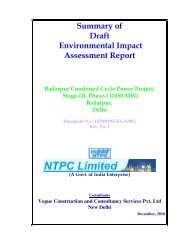EIA Studies of 3 Pre-Identified Hazardous Waste Disposal Sites in ...
EIA Studies of 3 Pre-Identified Hazardous Waste Disposal Sites in ...
EIA Studies of 3 Pre-Identified Hazardous Waste Disposal Sites in ...
Create successful ePaper yourself
Turn your PDF publications into a flip-book with our unique Google optimized e-Paper software.
Rapid <strong>EIA</strong> <strong>Studies</strong> <strong>of</strong> 3 <strong>Pre</strong>-identified <strong>Hazardous</strong> <strong>Waste</strong> <strong>Disposal</strong> <strong>Sites</strong> <strong>in</strong> NCT - Delhi:<br />
4.7 METEOROLOGY<br />
Page No.95<br />
4.7.1 Climate<br />
The climate <strong>of</strong> NCT, Delhi is ma<strong>in</strong>ly semi-arid and is largely <strong>in</strong>fluenced by its <strong>in</strong>land<br />
position and the prevalence <strong>of</strong> air <strong>of</strong> the cont<strong>in</strong>ental type dur<strong>in</strong>g the major part <strong>of</strong> the<br />
year. Extreme dryness with an <strong>in</strong>tensely hot summer and cold w<strong>in</strong>ter are the<br />
characteristics <strong>of</strong> the climate. Only dur<strong>in</strong>g the three monsoon months July, August<br />
and September does air <strong>of</strong> oceanic orig<strong>in</strong> penetrate to this district and causes<br />
<strong>in</strong>creased humidity, cloud<strong>in</strong>ess and precipitation. The year can broadly be divided<br />
<strong>in</strong>to four seasons. The cold season starts <strong>in</strong> late November and extends to about the<br />
beg<strong>in</strong>n<strong>in</strong>g <strong>of</strong> March. This is followed by hot season which lasts till about the end <strong>of</strong><br />
June when the monsoon arrives over the district. The monsoon arrives over the<br />
district. The dryness <strong>of</strong> the air with an <strong>in</strong>tensely hot summer and a cold w<strong>in</strong>ter are<br />
the characteristics <strong>of</strong> the climate. Air <strong>of</strong> oceanic orig<strong>in</strong> reaches the city only dur<strong>in</strong>g<br />
the three monsoon months, July, August and September, br<strong>in</strong>g<strong>in</strong>g with it <strong>in</strong>creased<br />
humidity, cloud<strong>in</strong>ess and ra<strong>in</strong>. The year may be divided <strong>in</strong>to four seasons. The cold<br />
season starts <strong>in</strong> late November and extends to the beg<strong>in</strong>n<strong>in</strong>g <strong>of</strong> March. This is<br />
followed by the hot season which lasts till about the end <strong>of</strong> June when the monsoon<br />
arrives over the region. The monsoon cont<strong>in</strong>ues to the last week <strong>of</strong> September. The<br />
two post monsoon months October and November constitute a transition period from<br />
the monsoon to w<strong>in</strong>ter conditions.<br />
4.7.2 Ra<strong>in</strong>fall<br />
The ra<strong>in</strong>fall with<strong>in</strong> NCT - Delhi are be<strong>in</strong>g recorded at 13 stations:<br />
1. Chandrawl (obsy) 2. New Delhi (Safd) 3. New Delhi (Palam)<br />
4. Okhala (obsy) 5. Mehrauli 6. Delhi (Sadar)<br />
7. Nangloi 8. Sahadara 9. Najafgarh<br />
10. Badli 11. Alipur 12. Narela<br />
13. Delhi (city)<br />
The normal annual ra<strong>in</strong>fall <strong>in</strong> the NCT -Delhi is 797.3 mm (50 years). Dur<strong>in</strong>g the<br />
period 1993 - 1997, annual average ra<strong>in</strong>fall observed was 905.32 mm. About 81% <strong>of</strong><br />
the annual ra<strong>in</strong>fall is received dur<strong>in</strong>g three monsoon months <strong>of</strong> july, August and<br />
September, while balance annual ra<strong>in</strong>fall is received as w<strong>in</strong>ter ra<strong>in</strong>s and as<br />
thunderstorm ra<strong>in</strong> dur<strong>in</strong>g pre and post-monsoon months. There have been a steady<br />
change <strong>in</strong> ra<strong>in</strong>fall from year to year. The maximum ra<strong>in</strong>fall recorded <strong>in</strong> the region was<br />
251% <strong>of</strong> the normal <strong>in</strong> 1933 while 44% <strong>of</strong> normal was the m<strong>in</strong>imum <strong>in</strong> 1951. A study<br />
<strong>of</strong> the trend <strong>of</strong> the annual ra<strong>in</strong>fall <strong>in</strong> the region for 80 years (1901 - 1980) shows that<br />
precipitation is mostly erratic <strong>in</strong> its arial distribution and <strong>in</strong>tensity. The ra<strong>in</strong>fall<br />
<strong>in</strong>creases from South west to north east.<br />
On average, ra<strong>in</strong>s <strong>of</strong> 2.5 mm or more falls on 27 days <strong>in</strong> a year. Of these, 19 days<br />
are covered under monsoon months; two to three days <strong>in</strong> June while rest <strong>in</strong> other<br />
seasons.<br />
Environment Division, National Productivity Council, New Delhi<br />
4
















